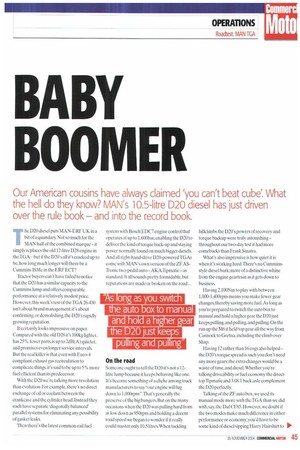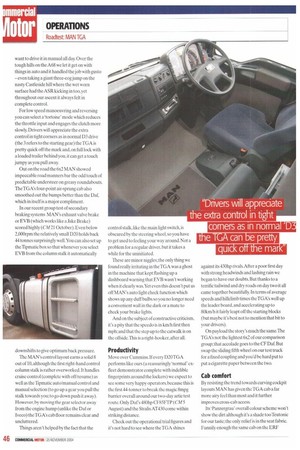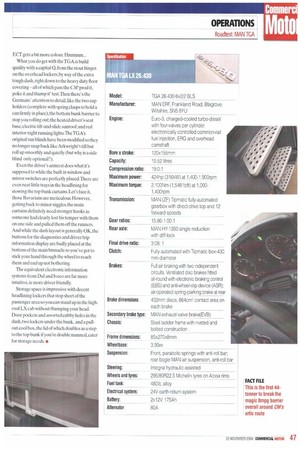111 BOOMER
Page 45

Page 46

Page 47

If you've noticed an error in this article please click here to report it so we can fix it.
Our American cousins have always claimed 'you can't beat cube'. What the hell do they know? MAN's 10.5-litre D20 diesel has just driven over the rule book — and into the record book.
The D20 diesel puts MAN-ERF UK in a bit of a quandary. Not so much for the MAN half of the combined marque —it simply replaces the old 12-litre D28 engine in the TGA —but if the D20's all it's cracked up to be, how long much longer will there be a Cummins ISMe in the ERF ECT?
Tractor buyers can't have failed to notice that the D20 has a similar capacity to the Cummins lump and offers comparable performance at a relatively modest price. However, this week's test of theTGA 26.430 isn't about brand management:it's about confirming, or demolishing, the D20's rapidly growing reputation.
It certainly looks impressive on paper. Compared with the old D28 it's 100kg lighter, has 25% fewer parts, is up to 2dB(A) quieter, and promises even longer service intervals. But the real killer is that even with Euro-4 compliant exhaust gas recirculation to complicate things, it's said to be up to 5% more fuel efficient than its predecessor.
With the D20 we're talking more revolution than evolution. For example, there's no direct exchange of oil or coolant between the crankcase and the cylinder head. Instead they each have separate 'diagonally balanced' parallel systems for eliminating any possibility of gasket leaks.
Then there's the latest common-rail fuel system with Bosch EDC7 engine control that operates at up to 1,600bar, enabling the D20 to deliver the kind of torque back-up and staying power normally found on much bigger diesels. And all right-hand-drive D20-poweredTGAs come with MAN's own version of the ZFASTronic two-pedal auto — AKATipmatic — as standard. It all sounds pretty formidable. but reputations are made or broken on the road...
On the road
Someone ought to tell the D20 it's not a 12litre lump because it keeps behaving like one. It's become something of a cliche among truck manufacturers to say "our engine will lug down to 1,00Orpm".That's generally the preserve of the big bangers. But on the many occasions when the D20 was pulling hard from as low clown as 950rpm and holding a decent road speed we began to wonder if it really could muster only 10.5 litres. When tackling hillclimbs the D20's powers of recovery and torque backup were truly astonishing — throughout our two-day test it had more comebacks than Frank Sinatra.
What's also impressive is how quiet it is when it's working hard.There's no Cumminsstyle diesel bark; more of a distinctive whine from the engine geartrain as it gets down to business.
Having 2.100Nm to play with between 1.000-1,400rpm means you make fewer gear changes, thereby saving more fuel.As long as you're prepared to switch the auto box to manual and hold a higher gear the D20 just keeps pulling, and pulling, and pulling. On the run up the M6 it held top gear all the way from Cannock to Gretna. including the climb over Shap.
Having 12 rather than 16 cogs also helped — the D20's torque spread is such you don't need any more gears; the extra changes would be a waste of time, and diesel.Whether you're talking driveability or fuel economy the directtop Tipmatic and 3.08:1 back axle complement the D20 perfectly.
Talking of the ZF auto box, we used its manual mode more with theTGA than we did with. say. the Daf CF85. However, we doubt if the two modes make much difference in either performance or economy; you'd have to be some kind of diesel sipping Harry Hairshirt to IV" want to drive it in manual all day. Over the tough hills on the A68 we let it get on with things in auto and it handled the job with gusto — even taking a giant three-cog jump on the nasty Castleside hill where the wet worn surface had the ASR kicking in too, yet throughout our ascent it always felt in complete control.
For low speed manoeuvring and reversing you can select a 'tortoise' mode which reduces the throttle input and engages the clutch more slowly. Drivers will appreciate the extra control in tight corners as in normal D3 drive (the 3 refers to the starting gear) the TGA is pretty quick off the mark and, on full lock with a loaded trailer behind you. it can get a touch jumpy as you pull away.
Out on the road the 6x2 MAN showed impeccable road manners bar the odd touch of predictable understeer on greasy roundabouts. The TGA's four-point air-sprung cab also smoothed out the bumps better than the Daf, which in itself is a major compliment.
In our recent group test of secondary braking systems MAN's exhaust valve brake or EVB (which works like a Jake Brake) scored highly (CM 21 October). Even below 2,000rpm the relatively small 1)20 holds back 44 tonnes surprisingly well.You can also set up the Tipmatic box so that whenever you select EVB from the column stalk it automatically downshifts to give optimum back pressure.
The MAN's control layout earns a solid 8 out of 10, although the first right-hand control column stalk is rather overworked. It handles cruise control (complete with off/resume) as well as theTipmatic auto/manual control and manual selection (to go up a gear you pull the stalk towards you:to go down push it away). However, by moving the gear selector away from the engine hump (unlike the Daf or lveco) the TGA's cab floor remains clear and uncluttered.
Things aren't helped by the fact that the control stalk, like the main light switch, is obscured by the steering wheel, so you have to get used to feeling your way around. Not a problem for a regular driver, but it takes a while for the uninitiated.
These are minor niggles:the only thing we found really irritating in the TGA was a ghost in the machine that kept flashing up a dashboard warning that EVB wasn't working when it clearly was.Yet even this doesn't put us off MAN's auto light check function which shows up any duff bulbs so you no longer need a convenient wall in the dark or a mate to check your brake lights.
And on the subject of constructive criticism, it's a pity that the speedo is in km/h first then mph; and that the step up to the catwalk is on the offside.This is a right-hooker, after all.
Productivity
Move over Cummins, if every D2OTGA performs like ours (a reassuringly 'normal' exfleet demonstrator complete with indelible fingerprints around the lockers) we expect to see some very happy operators, because this is the first 44-tormer to break the magic 8mpg barrier overall around our two-day artic test route. Only Des 480hp CF85FTP ( CM 5 August) and the Stralis AT430 come within striking distance.
Check out the operational trial figures and it's not hard to see where the TGA shines against its 430hp rivals.After a poor first day with strong headwinds and lashing rain we began to have our doubts. But thanks to a terrific tailwind and dry roads on day two it all came together beautifully. In terms of average speeds and hillclimb times the TGA's well up the leader board, and accelerating up to 80km/hit fairly leapt off the starting blocks (but maybe it's best not to mention that bit to your drivers).
On payload the story's much the same.The TGA's not the lightest 6x2 of our comparison group; that accolade goes to the CF Dad. But swap the sliding fifth wheel on our test truck for a fixed coupling and you'd be hard put to put a cigarette paper between the two.
Cab comfort
By resisting the trend towards curving cockpit layouts MAN has given the TGA cab a far more airy feel than most and it further improves cross-cab access.
Its 'Panzergrau' overall colour scheme won't show the dirt although it's a shade tooTeutonic for our taste; the only relief is in the seat fabric. Funnily enough the same cab on the ERF ECT gets a bit more colour. Hmmnun...
What you do get with the TGA is build quality with a capital Q, from the stout hinges on the overhead lockers, by way of the extra tough dash,right down to the heavy duty floor covering all of which pass the CM'prod it, poke it and thump it' test.Then there's the Germans' attention to detail, like the two cup holders (complete with spring clasps to hold a can firmly in place); the bottom bunk barrier to stop you rolling out; the heated driver's seat base; electric tilt-and-slide sunroof; and red interior night running lights.TheTGAs original sun blinds have been modified so they no longer snap back like Arkwright's till but roll up smoothly and quietly (but why is a side blind only optional?).
Even the driver's armrest does what it's supposed to while the built in window and mirror switches are perfectly placed.There are even neat little trays in the headlining for stowing the top bunk curtains. Let's face it, those Bavarians are meticulous. However, getting back to minor niggles, the main curtains definitely need stronger hooks as someone had clearly lost his temper with them on one side and pulled them off the runners. And while the dash layout is generally OK, the buttons for the diagnostics and driver/trip information display are badly placed at the bottom of the main binnacle so you've got to stick your hand through the wheel to reach them and end up not bothering.
The equivalent electronic information systems from Daf and Iveco are far more intuitive, ie more driver friendly.
Storage space is impressive with decent headlining lockers that stop short of the passenger area so you can stand up in the highroof LX cab without thumping your head. Door pockets and assorted cubby holes in the dash, two lockers under the bunk, and a pullout cool box. the lid of which doubles as a step to the top bunk if you're double manned,cater for storage needs.
























































































































































































